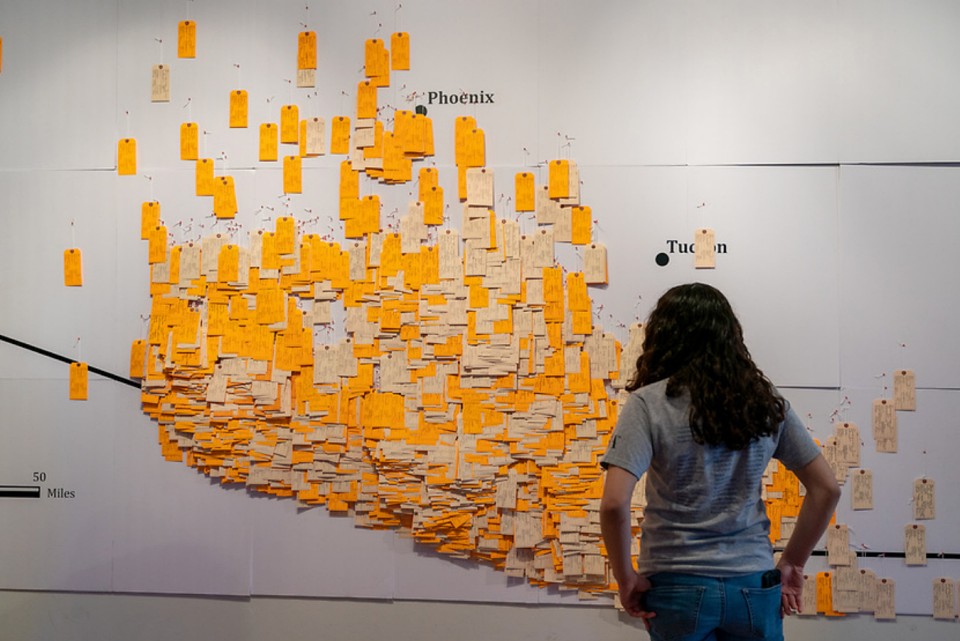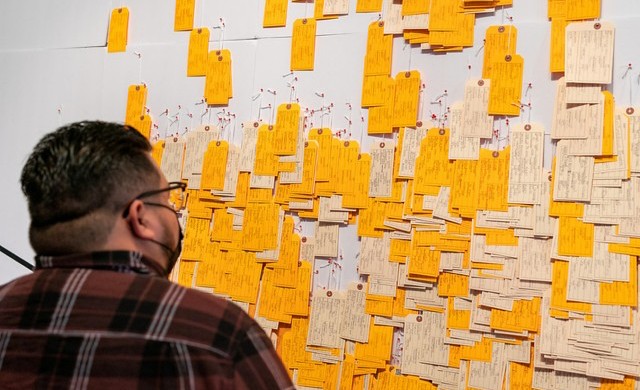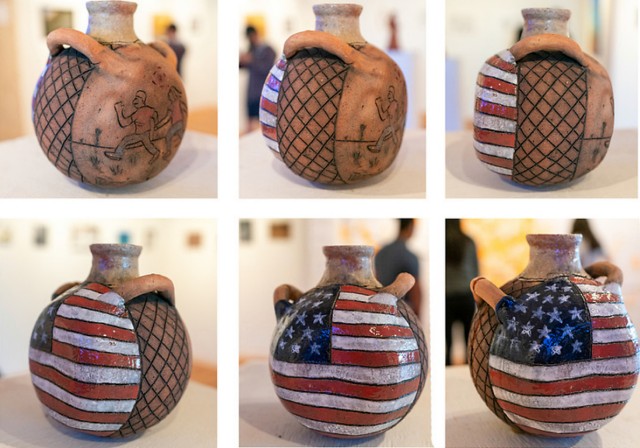By -
RIO GRANDE VALLEY, TEXAS – A pop-up installation featuring more than 3,200 handwritten toe tags representing immigrants who have lost their lives crossing the Sonoran Desert of Arizona currently is on display at UTRGV.
The global pop-up exhibit, Hostile Terrain 94 is sponsored by the UTRGV College of Liberal Arts and is organized by the Undocumented Migration Project.
The exhibit pays homage to the thousands of people who have died while crossing the U.S.-Mexico border since the mid-1990s as a direct result of the U.S. border enforcement policy known as “Prevention Through Deterrence.”
The exhibit can be seen at the Rusteberg Gallery on the UTRGV Brownsville Campus through Nov.11, and at the University Library on the Edinburg Campus through Nov. 19.
With over 150 pop-up installations being exhibited globally and nationally, the participatory art exhibit involves more than 3,200 toe tags filled out by teams of volunteers, who then place the tags in the exact locations on a wall map where the deceased were found.
At UTRGV, student and community volunteers spent several days in September personalizing each toe tag during “Tag-Filling Activities” and lunch sponsored by the Center for Latin American Arts and led by Dr. Sarah Rowe, anthropology associate professor at UTRGV and the exhibit coordinator.
Jason de Leon, head curator of Hostile Terrain 94, executive director of the Undocumented Migration Project and professor of Anthropology and Chicano and Central American Studies at the University of California Los Angeles, said the exhibit is designed to not only memorialize migrant deaths, but also to make people aware that casualties are more than just numbers.
“I think that people need to be reminded that we're living in a global migration crisis,” De Leon said. “People often forget that, so the hope is that we can educate them and encourage them to work for more positive social change.”
Hostile Terrain 94 was developed in fall 2018 and took more than a year and a half to reach a place where it could operate smoothly, De Leon said.
One of the largest hardships in finalizing the project, he said, was preparing the logistics and detailed instructions for each installation.
“I would say it's still an evolving project,” he said. “Every exhibition is different, and we're constantly working with our collaborators to figure out how to make it relevant to the communities in which they are installing it.”
To complement the exhibit at UTRGV, a juried student art exhibit is also included and features art pieces that honor migrants who have lost their lives while making the journey to the United States.
More than 30 pieces of student art were submitted at UTRGV, and three winners, along with an audience favorite, were awarded prizes during a reception on Nov. 1 at the Rusteberg Art Gallery.
Rowe encourages those interested in learning more about the immigration crisis to visit the exhibit and student art showcase, and to read De Leon’s The Land of Open Grave, which reflects on the impact the “Prevention Through Deterrence” policy has had on immigrants.
“If we really want to raise awareness about the issue,” Rowe said. “We need to push our political representatives to be aware of this policy and try to find alternatives that are a more humane solution.”
For more information about Hostile Terrain 94 at UTRGV, visit https://www.utrgv.edu/hostile-terrain-94/.
ABOUT UTRGV
The University of Texas Rio Grande Valley (UTRGV) was created by the Texas Legislature in 2013 as the first major public university of the 21st century in Texas. This transformative initiative provided the opportunity to expand educational opportunities in the Rio Grande Valley, including a new School of Medicine and a School of Podiatry, and made it possible for residents of the region to benefit from the Permanent University Fund – a public endowment contributing support to the University of Texas System and other institutions.
UTRGV has campuses and off-campus research and teaching sites throughout the Rio Grande Valley including Brownsville (formerly The University of Texas at Brownsville campus), Edinburg (formerly The University of Texas-Pan American campus), Harlingen, Weslaco, McAllen, Port Isabel, Rio Grande City and South Padre Island. UTRGV, a comprehensive academic institution, enrolled its first class in the fall of 2015; the School of Medicine welcomed its first class in the summer of 2016, and the School of Podiatric Medicine in the fall of 2022.



